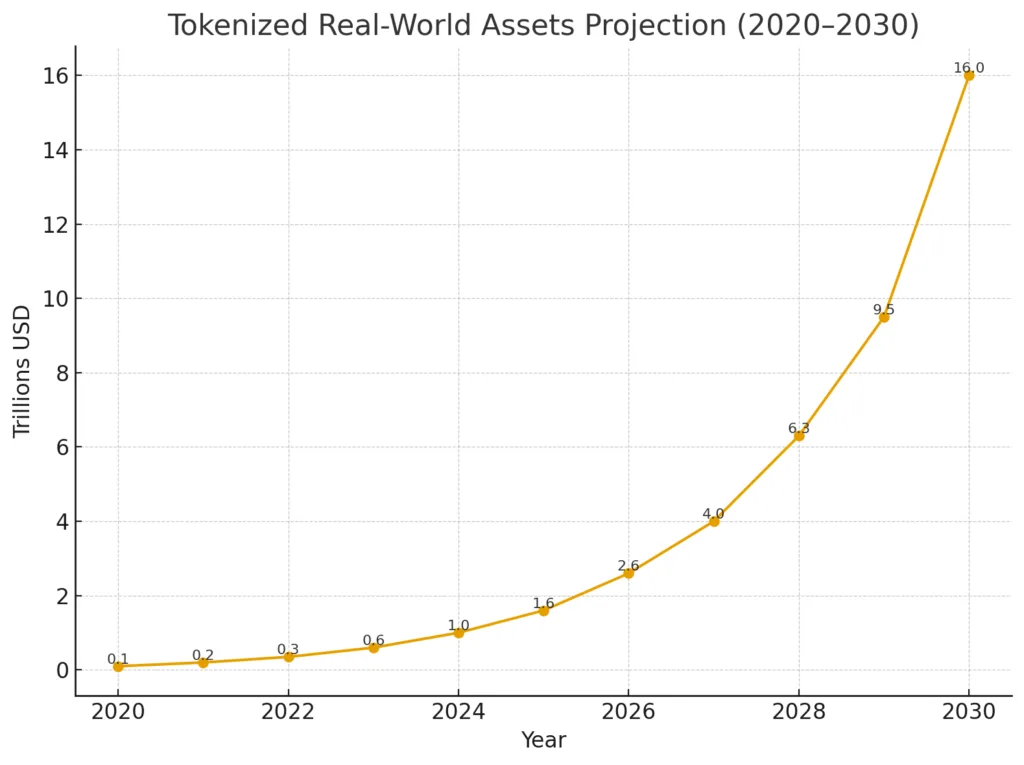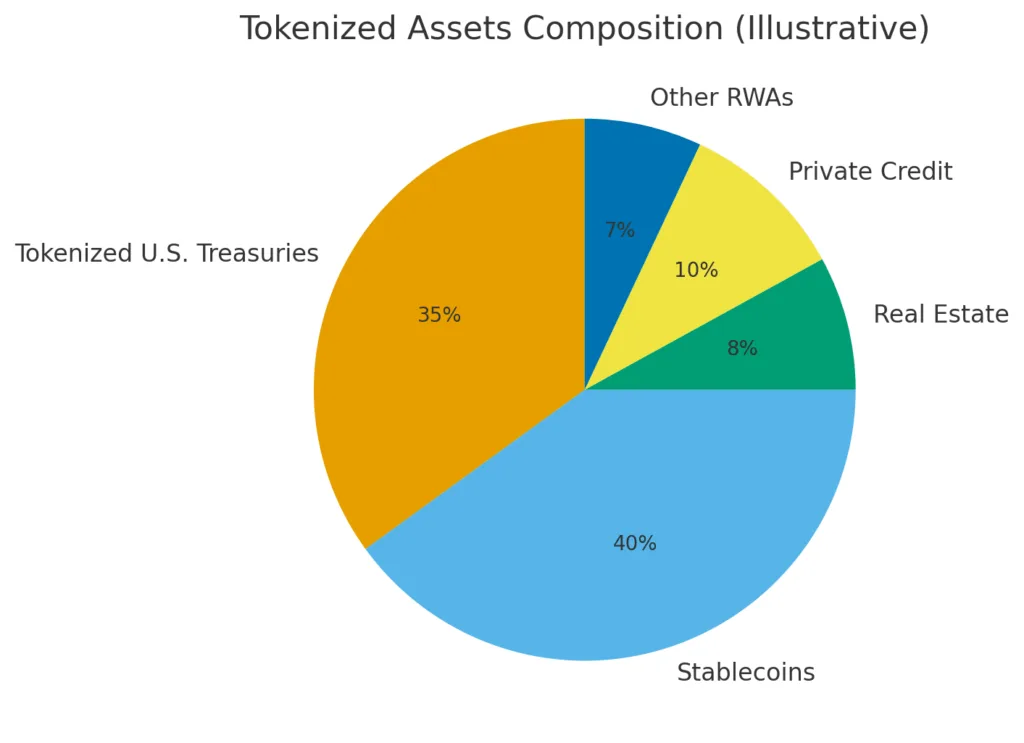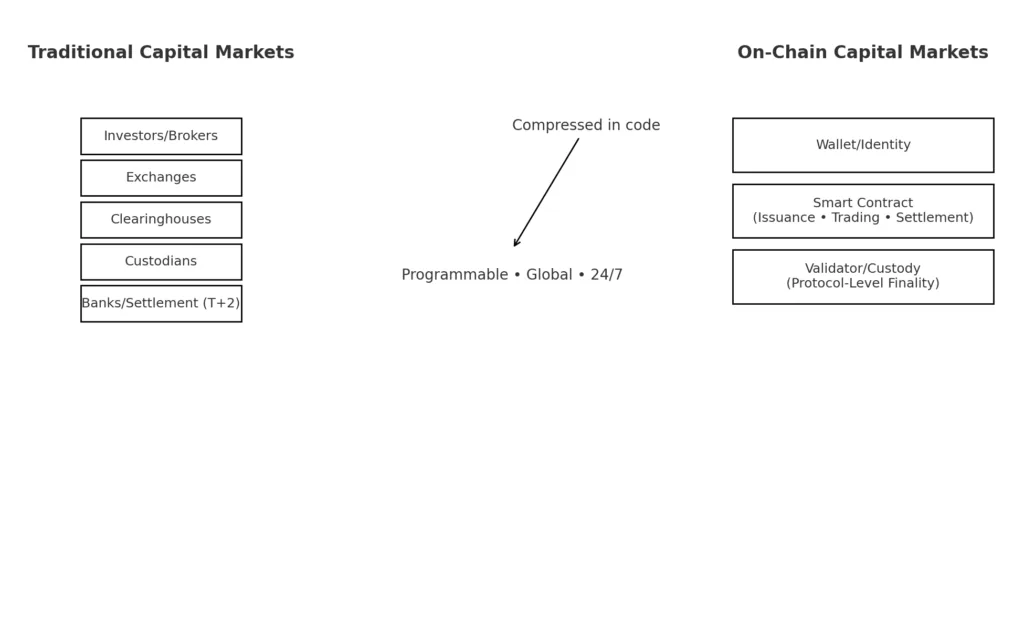- On-chain capital markets are revolutionizing conventional finance by allowing immediate settlement, clarity, and worldwide access without intermediaries.
- The tokenization of treasuries, real estate, and credit is picking up speed, with experts estimating that as much as $16 trillion in assets might transition to on-chain by 2030.
- The evolution of finance could be characterized by the merging of Wall Street and DeFi, resulting in a programmable worldwide marketplace that operates continuously.
For over a hundred years, the worldwide financial framework has centered on key locations like Wall Street in New York, the City of London, and the towering buildings where banks, brokers, and clearinghouses manage capital movements. In the realm of cryptocurrency, a novel type of market is emerging, one that is borderless, lacking trading floors, and free of intermediaries. These comprise on-chain capital markets, and they are transforming the movement of money, credit, and assets worldwide.
The narrative of on-chain capital markets goes beyond merely technology. It involves rethinking the core of finance by substituting paperwork, settlement lags, and regulatory barriers with programmable currency, immediate clearing, and open ledgers. In summary, crypto is creating a Wall Street that has no barriers
From Wall Street to Wallet Street
Conventional capital markets are intricate. A transaction of one stock includes brokers, exchanges, clearinghouses, custodians, and banks. Settlement typically requires two days (T+2), and each phase is governed by multiple regulations and manual supervision. For years, this system has functioned, yet it has also caused inefficiencies, expenses, and obstacles to entry.
Newsletter
Get weekly updates on the newest crypto stories, case studies and tips right in your mailbox.
In contrast, on-chain markets condense this structure into code. A smart contract can generate securities, connect buyers and sellers, transfer ownership, and finalize transactions in mere seconds, rather than days. Issuance and settlement can now occur directly on a blockchain, available to anyone with a wallet, rather than being limited to trading floors or private transactions.
This change is already apparent in the figures. Analysts predict that approximately $16 trillion in assets might be tokenized and transferred on-chain by the year 2030. That forecast indicates genuine institutional interest in the digitization of everything from U.S. Treasuries to real estate.

Tokenization and the New Asset Classes
Central to on-chain capital markets is tokenization: the method of depicting real-world assets as tokens on the blockchain. Treasuries have become the proving ground. Over the past year, companies such as BlackRock with its BUIDL fund and Franklin Templeton with its on-chain bond offerings have introduced government securities to Ethereum and Stellar, drawing in billions of dollars.
Central to on-chain capital markets is tokenization: the method of depicting real-world assets as tokens on the blockchain. Treasuries have become the proving ground. Over the past year, companies such as BlackRock with its BUIDL fund and Franklin Templeton with its on-chain bond offerings have introduced government securities to Ethereum and Stellar, drawing in billions of dollars.
Stablecoins serve as the settlement layer that enables all of this. Circulating over $150 billion, they act as on-chain dollars, allowing for immediate payments, continuous trading, and seamless settlement among tokenized assets.

Infrastructure of On-Chain Capital Market
The reason on-chain finance seems groundbreaking is due to both the assets being generated and the infrastructure backing them. In conventional markets, various entities oversee issuance, trading, custody, clearing, and settlement. On-chain, software dismantles these barriers.
Smart contracts manage issuance, trading, and settlement at the same time. Oracles such as Chainlink and Pyth deliver real-world price and event information to the blockchain, enabling a wide range of applications from derivatives to lending protocols. Liquidity pools offer around-the-clock credit markets, removing the necessity for centralized market makers. The whole system operates nonstop and worldwide, with transactions displayed on public ledgers and settlements linked to the network’s block time.

On-chain markets collapse the traditional financial stack brokers, exchanges, custodians, and clearinghouses into programmable smart contracts.
Opportunities and Risks
The advantages of on-chain markets are considerable. Settlement occurs immediately, minimizing counterparty risk and liberating capital. The system incorporates transparency, allowing both regulators and investors to monitor flows in real time. Accessibility increases, as anyone with funds can invest in offerings that were previously limited to institutions or accredited investors. Programmability opens up completely new opportunities, ranging from yield-generating stablecoins to composable ETFs.
Nevertheless, the risks cannot be overlooked. Countless billions have been lost due to hacks and exploits on smart contracts. Liquidity continues to be scattered among different blockchains and protocols, hindering adoption. Regulatory ambiguity persists in the sector, as governments engage in discussions on how to categorize tokenized assets and how to ensure compliance without hindering innovation. Political leaders like Senator Elizabeth Warren continue to view crypto mainly as a risk, despite institutions like BlackRock, Citi, and JPMorgan increasing their involvement.
Wall Street Without Walls
What is happening is not a substitution for Wall Street but rather a merging. On-chain markets won’t eliminate traditional financial institutions, yet they are quickly emerging as the framework on which those institutions might ultimately operate. ETFs currently offer access to Bitcoin and Ethereum, connecting regulated investment vehicles with blockchain assets. Custodial services and compliant stablecoins are establishing the foundation for broader institutional acceptance
Future capital markets might resemble the global frameworks of Ethereum or Solana rather than the trading floors of the New York Stock Exchange. Brokers, exchanges, and clearinghouses won’t disappear; instead, they’ll transform into validators, protocol managers, and foundational service providers within a code-driven system.
As noted by a tokenization executive, on-chain markets aim not to dismantle Wall Street, but to reconstruct it without the barriers. The forthcoming evolution of capital markets could be worldwide, programmable, and accessible to anyone, anywhere, signifying the shift from Wall Street to wallet street.













